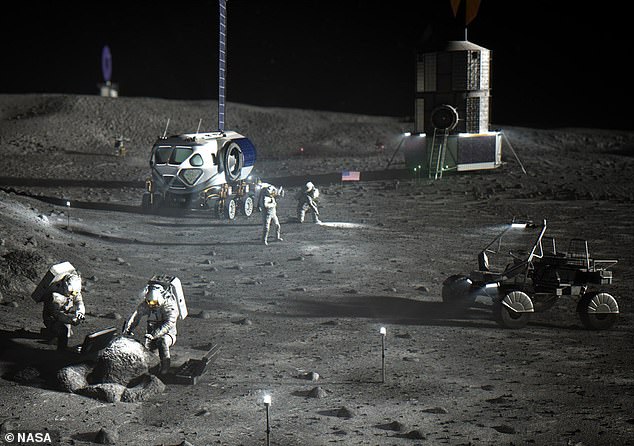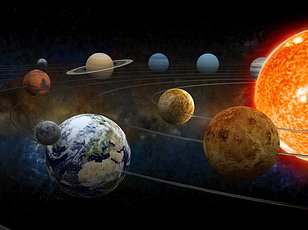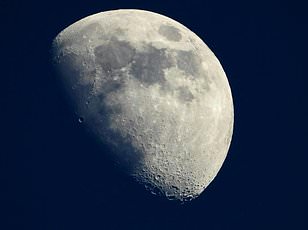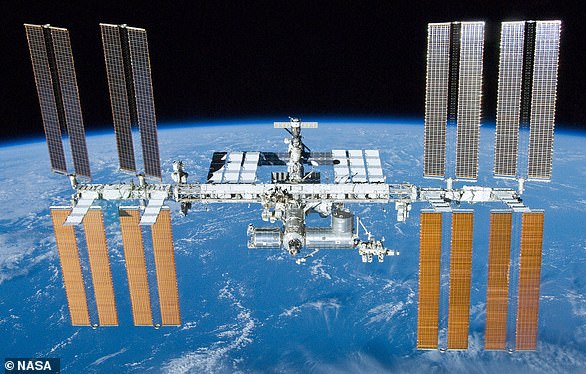3D-printed houses, Prada spacesuits and laser-cut football pitches: What life on the moon will REALLY look like - as scientists discover a secret cave under the lunar surface
- NASA hopes to set up Artemis Base Camp as soon as later in the decade
- READ MORE: The moon has a secret underground CAVE, scientists reveal
Plans to put a human colony on the moon took a promising step forward this week as scientists in Italy revealed they've found the first lunar cave.
It could be a site for a lunar base, as it offers shelter from 'the harsh surface environment' and could support long-term human exploration of the moon.
It comes as NASA continues with its ambition to set up its 'Artemis Base Camp' in the lunar south region within the decade – but what could this look like?
MailOnline spoke to experts to find out how the first settlers could set up camp on our lunar satellite and what sort of facilities it may have.
Moondwellers could live and sleep in 3D-printed houses, or eventually play football on laser-cut pitches in their Prada spacesuits.

Moondwellers could live and sleep in 3D-printed houses, or eventually play football on laser-cut pitches in their Prada spacesuits

NASA hopes to develop a sustainable lunar exploration program starting from 2028. This artist's illustration shows what NASA's Artemis base camp could look like
NASA's upcoming Artemis III mission plans to land a crew at the moon's south polar region in a SpaceX craft.
Eventually as part of its Artemis programme, NASA plans to have set up a base camp in the lunar south region by the end of this decade.
Spacesuit-clad astronauts could take a drive on moon buggies featuring adverts on the side, or even eventually get around by a Scalextric-inspired system of trains.
While designs for lunar bases are still being considered by NASA, they would need to protect humans from cancer-causing cosmic rays and unforgiving temperatures.
'The conditions on the moon are harsh,' Dr Daniel Brown, associate professor in astronomy at Nottingham Trent University, told MailOnline.
'No atmosphere that would support life and also the temperatures are extreme from exceedingly cold (think of liquid nitrogen) to very hot (above boiling temperature of water on Earth).

NASA wants to build a Scalextric-style railway on the moon which uses floating robots to carry materials along a flexible track (artist's depiction, pictured)

Tranquility Base, the location of the first manned landing on the moon in July 1969, is located in the south-western corner of the Sea of Tranquility. Pictured is Buzz Aldrin during the Apollo 11 moon landing on July 20, 1969
'So initially it would need to be an environment that can be pressurised to have a breathable atmosphere and also insulated enough to maintain a stable comfortable temperature.'
Matthew Cosby, director of space engineering at Goonhilly Earth Station, thinks a lunar base would be built in stages, similar to the International Space Station (ISS).
'The first step would be the basics – power, communications and safe operations to ensure that we can have a sustained human and robotic presence on the moon,' he told MailOnline.
These essentials might include living quarters, transport and some sort of infrastructure to generate power, such as an array of solar panels.
Once deployed on the surface, this architecture would then be assembled with a 'mixture of human and robotic' equipment – 'not one or the other', Mr Cosby said.
Facilities in the living quarters would include beds, toilets laboratories, exercise equipment to stave off bone and muscle wastage.
But what would the building be made out of?
One option is lunar regolith (the moon's soil), which has special reflective properties and could act as a shield against incoming radiation particles, heat and space rocks.

Astrolab is aiming to send its 'Flex' rover to the moon in 2026. Ads could potentially be displayed on the side of the buggy, which has been designed to transport humans and materials around the moon (MailOnline's impression)

This 1.5 tonne building block was produced as a demonstration of 3D printing techniques using lunar soil

Artemis is the successor to NASA's Apollo programme of the 1960s and 1970s. In this famous NASA photo, astronaut Buzz Aldrin Jr. poses for a photograph beside the US flag on the moon during the Apollo 11 mission on July 20, 1969
Mr Cosby said: 'There has been a considerable amount of research into using the lunar regolith in the construction of a lunar habitat.
['This is] either by using this as a source of material for a 3D printed shell, or covering a habitat created on the Earth and sent to the moon.'
Dr Brown said NASA needs to avoid taking lots of Earth material – such as bricks and steel trusses – up to the moon as this is very expensive.
Living quarters underground – such as in caves – could be a practical solution, because it would provide extra cover from the unforgiving environment, he added.
With sufficient protection, humans inside would be able to take off their spacesuit – potentially designed by Prada – and walk around in normal clothing, similar to personnel on the ISS now.

With sufficient protection while inside a moon base, humans inside would be able to take off their spacesuit and walk around in normal clothing, similar to personnel on the ISS now. Pictured, astronauts Michael Hopkins (left) and Rick Mastracchio (right) on the ISS in 2013
Dr Brown agreed that the assembly process would have to be done by humans and robotics.
'Many things can be done robotically, but these will need to be supported by human interaction at some point,' he said.
'So we could envisage a small habitat being constructed first that allows limited occupation while the larger complex is being constructed.'
Currently, astronauts on the ISS eat food out of small pouches that are rehydrated and heated, which are of course prepared on Earth.
But as lunar astronauts are expected to spent much longer periods of time in space, food may need to be grown on the moon.
Items on a moon menu could include artificial steak grown from beef cells and edible plants that can grow from the lunar regolith.

Scientists have taken 'one small step' towards growing plants on the lunar surface, after showing it's possible to grow thale cress in lunar soil
Eventually, once the basics are established, a colony could be transformed into a bustling 'moon city', with spaceports, amusements and even a football pitch, with markings carved into the lunar soil with lasers.
NASA's Artemis III mission – the first mission to put people on the moon in over 50 years – aims to land at the lunar south region.
Space agencies are generally interested in landing at the southern region of the moon due to the rich reserves of water there, frozen as ice.
It could be a source of drinking water for moon explorers and could help cool equipment, or be broken down to produce hydrogen for fuel and oxygen to breathe.
'The most essential feature for a successful human community on our Moon is water,' Michelle Hanlon, space law professor at the University of Mississippi, told MailOnline.
'They will need water for themselves, and to grow plants they will need to survive.
'They will also want to be able to process and break down water ice to its component parts of hydrogen and oxygen to support them (oxygen) and also to create propulsion (hydrogen) so their instruments and other operating machinery can operate even without direct access to sunlight.'
Ultimately, there are still many decisions NASA has to make regarding how the first lunar base camp would be established as part of its delayed Artemis programme.
But this is quickly becoming a cause for concern as NASA aims to set up the base as soon as the end of this decade.
Malcolm Macdonald, space technology engineer at the University of Strathclyde, said he doesn't don’t expect Artemis III (NASA’s return to the lunar surface) to happen before 2028, even though NASA says it will happen September 2026.
'The Lunar Gateway (a space station in orbit about the moon) is already being built on the ground to feed into the Artemis programme,' he told MailOnline.
'But I can’t see a lunar surface base being seriously pursued until well into the 2030s.'






































































































































































































